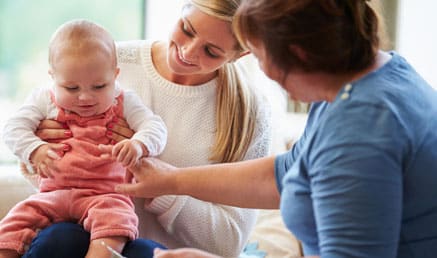
“It’s our polite nudge in the ribs to help you and your team stay organised and on task.”
This week’s subject is: Nappy change and toileting.
Element 2.1.2: Effective illness management and hygiene practices are promoted and implemented
How does your Service ensure that nappy change and toileting routines support effective health, hygiene and safety whilst ensuring their interactions with children are warm and responsive and that the dignity and rights of each child are maintained?
Educators must ensure that high standards of hygiene are maintained during nappy change and toileting procedures to minimise the spread of illness and infectious diseases. When reviewing your procedures and practices for safe and hygienic nappy change and toileting routines, consider and ensure the following:
-
- All educators are familiar with and implement the Service’s Nappy Change and Toileting Policy and Procedures and ensure nappy change procedures and practices support children’s health, safety, protection, relationships, language and learning
- educators ensure effective supervision is maintained at all times and children are never left unattended on the nappy change mat/surface
- the nappy change and hand washing procedure is displayed in the nappy change area
- the nappy change area cleaning procedure is clearly displayed in the nappy change area
- a child friendly hand washing poster/procedure is displayed in the children’s toilets
- educators ensure appropriate preparation including cleaning and direct access to supplies prior to bringing children into the nappy change area
- educators consistently role model effective hand washing practices
- having separate nappy change surface/mats (for each room) reduces the risk of spread of illness from one room to another (recommended best practice; Staying Healthy: Preventing infectious diseases in ECEC-5th Edition)
- educators foster warm and responsive relationships during nappy change and toileting routines through positive discussions and interactions
- all soiled items (nappies, wipes, paper towels) are immediately disposed of in a hand-free lidded rubbish bin
- any soiled clothing is placed in a bag and sealed
- educators use gloves and ensure effective hand washing prior and following the use of gloves. Educators also ensure they remove gloves safely as per guidelines outlined in “NHMRC-Staying Healthy”
- educators support children’s agency to develop an understanding and control of their own bodily functions
- nappy creams are only administered to children with an authorisation provided by a parent/guardian or authorised nominee via an Administration of Medication form
- educators engage in age-appropriate activities with children, such as singing, chanting, or saying rhymes during nappy change and toileting routines
- educators and students under the age of 18 will be directly supervised by an educator over the age of 18 at all times (r120)
- the Service provides opportunities for families to communicate children’s individual needs
- educators minimise lifting children by guiding/encouraging mobile children to climb the steps to the nappy change table and where a child is not walking, educators implement manual handling practices to lift and carry the baby onto the nappy change table/mat
- educators document and share with families children’s nappy change and toileting routines throughout the day via parent’s specified, preferred methods of communication
- educators promote children’s independence by encouraging self-help skills during toileting, hand washing and dressing
- educators work collaboratively with families to communicate children’s needs and ensure consistency during toilet training
School age care:
-
- educators ensure adequate supervision during toileting by monitoring when children enter and exit children’s bathrooms
- educators respect the dignity and rights of each child by ensuring their right to privacy and ensure that they provide assistance to any child following a toileting accident discretely and sensitively
- ensure bathrooms are always equipped with soap and hand drying facilities and checks are completed prior to care sessions or when no children are present in the bathrooms
- children design and create hand washing posters for display in bathrooms and other hand washing facilities/areas
Resources:
Staying Healthy: Preventing infectious diseases in ECEC-5th Edition
Toileting and nappy changing principles and practices
NSW Health- Hand washing poster
Changing a nappy without spreading germs poster
Within System7 go to Quality Area 2/Module 2 & Quality Area 3/ Modules 16, 19, 21 to submit self-assessment notes and if required, open a QIP issue if you identify any areas of improvement.
The Childcare Centre Desktop has a range of resources to assist services with nappy change and toileting. These include Nappy Change and Toileting Policy and Procedure, Nappy Change Audit, Cloth Nappies Guide and Procedure, Nappy Change Record, Bathroom and Nappy Change Cleaning Checklist and much more.
Resources, NQS Element, Regulation and System7 links:
Childcare Centre Desktop – Childcare Centre Desktop
National Quality Standard – QA 2/ 2.1.2- Health practices and procedures
National Regulations – 106, 109, 112, 115, 155, 168
System7 Module – QA 2/ Module 2, QA 3/ Modules 16, 19, 21
If you have any questions send us a note via the Contact page here!




